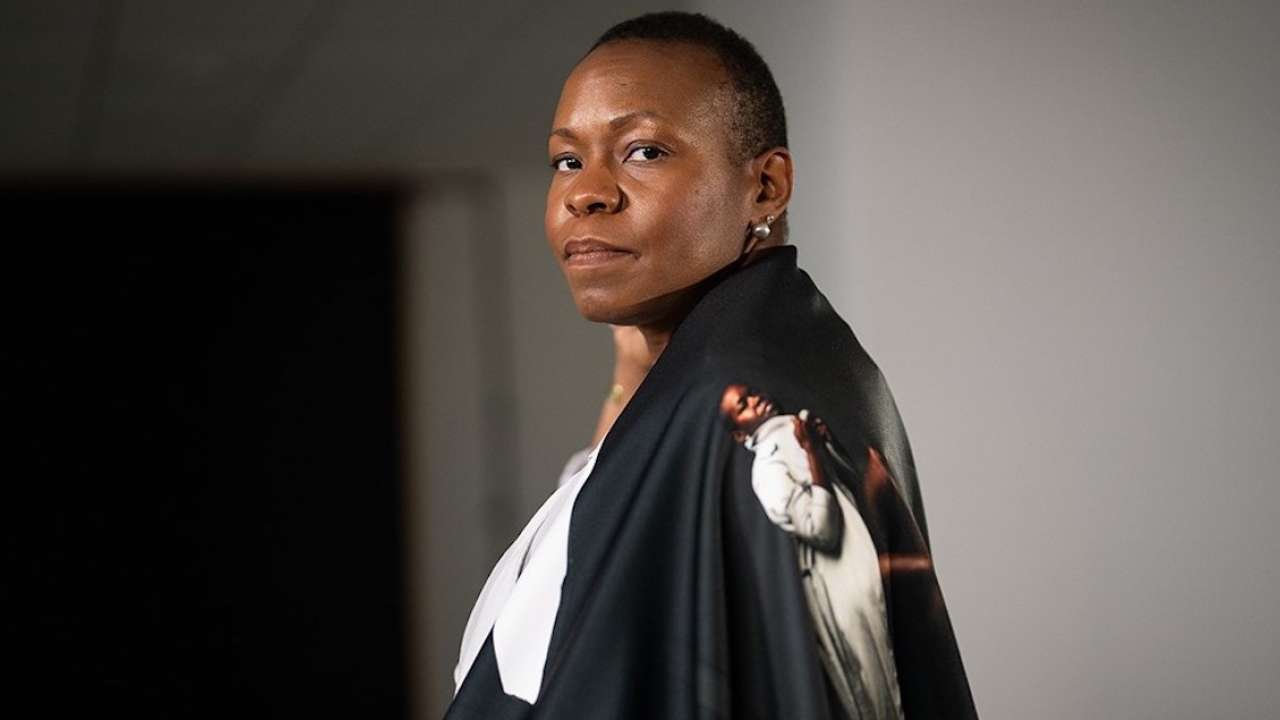
Interpreting the 5 stages of grief through fashion
The first thing Melissa Watkins did when she was diagnosed with breast cancer at age 41 was deny reality.
“They’re probably going to call me back any minute and say those weren’t actually my results,” she told herself.
When that didn’t happen, she plunged into despair, wondering, “Am I going to die?”
As Watkins underwent chemotherapy, surgery and radiation treatment at UCLA Health, she found herself vacillating through the five stages of grief — denial, anger, bargaining, depression and acceptance.
She completed treatment by the time her 42nd birthday came around in November 2022, and was determined to continue her tradition of celebrating with a fashion photo shoot.
A passionate fashionista who collects unique pieces by local designers, Watkins likes to memorialize her favorite outfits of the year by having them captured by a professional photographer as a birthday gift to herself. She shares the photos with friends or, occasionally, on a dating app.
But this photo shoot would be different. It would awaken a whole new part of herself, even if she didn’t know it yet.
Exploring grief through fashion
The shoot almost didn’t happen at all, because when the photographer she consulted with suggested she consider memorializing her health journey in some way, Watkins scoffed. She had already decided the shoot would have nothing to do with cancer. She wanted it to have a pretty, princess vibe.
“I actually said I want to forget it all happened,” Watkins recalls. “Let’s just erase it. I want frills and ruffles.”
She finished the meeting, dejected. And then it came to her: She would interpret the five stages of grief through fashion.
“Within like 10 minutes — no lie — I came up with the idea for the whole shoot, pulled out all the clothes and threw them in a bag,” Watkins says.
Once she had the concept, inspiration took over. She grabbed the wig she’d made from her own dreadlocks as they fell out during chemo. She pulled out her favorite night-on-the-town club dress: a funky brown sheath with a turtleneck that can be worn as a hood. This was denial.
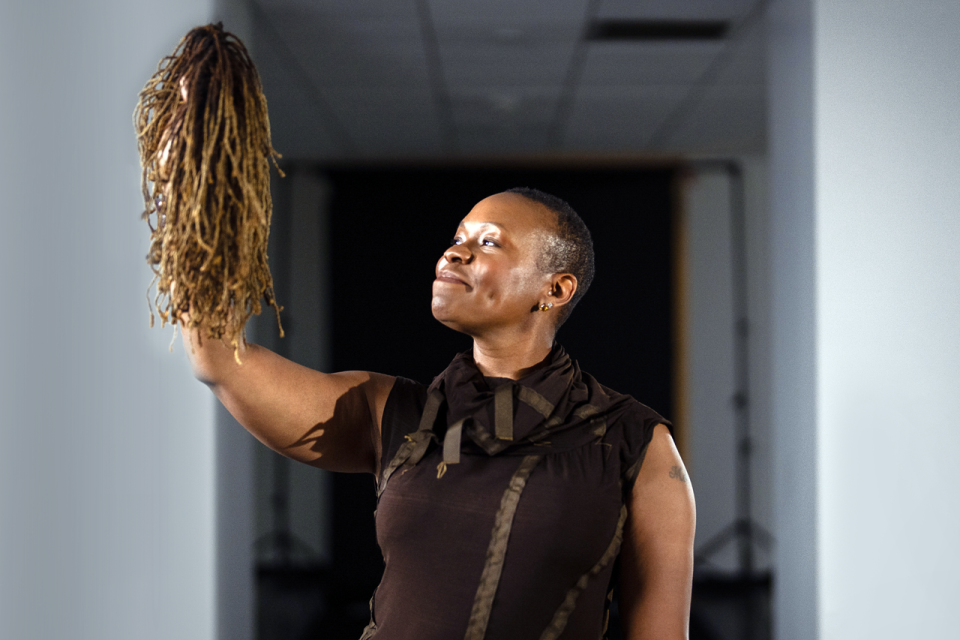
She picked up the prickly bodysuit her twin sister had given her — a sheer, black number covered with silver spikes. This was bargaining — a pointed negotiation with life and the transparency of pleading for a good outcome.
There was a gray trench coat (depression), a leather sarong with a red sash (anger) and a beaded, gold tunic that looks like something a royal goddess might wear (acceptance). Each outfit had corresponding jewelry, makeup and energy.
“The gift that came from just pulling that together — I had no regrets,” Watkins says. “On the day of the shoot, I walked in and said, ‘We’re going to do the five stages of grief. Here’s my outfits.’”
When the photographer showed her the proofs, Watkins knew this was more than just a personal photo shoot. This was something she wanted to share with anyone who ever had or ever would experience grief — which is, of course, everyone.
Building an art exhibit
This inspired her to do something she’d never done before: put together a gallery show. It would feature the five stages of grief photos and fashions and she’d call it “The Beauty of Acceptance.”
A professional fundraiser for Loyola Marymount University, Watkins has years of experience creating community connections. But she’d never held an event centered on her own artistic work.
She found a gallery in Long Beach, not far from where she lives, and booked the space. She printed up flyers and handed them out to strangers. She invited her friends and family and health care providers from UCLA.
And in March of 2023, Watkins publicly shared her love of fashion and the vulnerability of her cancer journey with hundreds of people.
“If I had to pick one thing in life that was the best thing I’ve ever done, it’s this,” Watkins says. “There’s so much beauty that comes from extreme pain. It’s transformed me in a way that reinforced this idea that something you might go through can be really, really hard or difficult or painful, but the other side of it can just be so much beauty and creativity and joy.
“The day I showed that exhibit was one of the happiest days of my life.”
Even though the day before the showing, she’d received terrible news.
An ongoing journey
Shortly before the exhibit opened, Watkins had seen UCLA Health radiation oncologist Susan McCloskey, MD for a three-month check-up — a PET scan to see if the cancer was gone. The next day, Dr. McCloskey called with an urgent message: Watkins would need another scan to look more closely at her brain.
The follow-up scan revealed a tumor.
“The day before the exhibit, I found out I’ve got a brain tumor,” Watkins says. “The timing couldn’t have been more perfect. Because if I had found out earlier, I would have canceled the exhibit. But this was the day before. So it was perfectly timed, because here was this outpouring of love from everybody” at the art opening.
Video from the event shows Watkins being a warm and welcoming host, despite the new diagnosis, which she kept to herself.
Dr. McCloskey says she often sees tremendous resilience in her patients, but Watkins is extraordinary. It’s not just her positive spirit, Dr. McCloskey says. It’s how Watkins uses her resilience to lend strength to others.
“People face this journey and come out empowered and stronger as they see what they’re capable of. Melissa has found a way to not only do that, but to let her own self-empowerment empower other women,” Dr. McCloskey says. “My whole staff says she’s a beaming, shining light.”
And a stylish one, too, as Watkins always expresses her singular sartorial flair wherever she goes — bright colors, exquisite tailoring and one-of-a-kind accessories, such as a ring that looks like an eagle’s talon.
Continuous discovery
Watkins had surgery to remove the brain tumor in March of 2023, which doctors discovered was fueled by the breast cancer. Subsequent scans have found other brain tumors. Watkins continues to receive chemotherapy.
She also continues to create art and share what she’s made. “The Beauty of Acceptance” is set to be shown to USC medical students in January to illuminate “the human side of illness,” Watkins says. She’s seeking other venues to show the exhibit, as well.
And when her birthday came around again in November 2023, she did another photo shoot.
“I’m adding pieces to commemorate the brain tumors,” she says. She chose the outfits months ago.
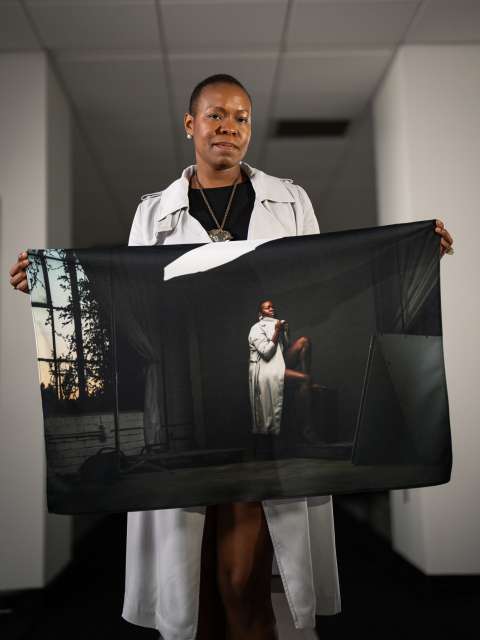
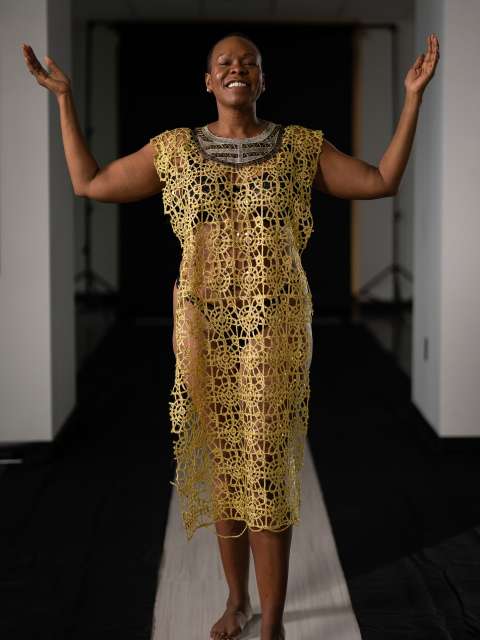
Watkins says her experience with cancer has made her “a new person.”
“Every week I’m doing something new with this art, and it’s given me this outlet to still find joy in the midst of — I’m still battling. But I point to this as a way to escape and a way to find grounding and peace,” she says. “Cancer is, like, saving my life while threatening to kill me at the same time.”
Inspiring others
Shiori Lange, LCSW, a clinical social worker with the Simms/Mann-UCLA Center for Integrative Oncology, met Watkins in September 2023. During their regular new-patient intake session, Watkins mentioned her art project.
“I was speechless when I first saw it,” Lange says. “It really hit my heart — how strong she is as a person; her strength, her wisdom and the courage it took to put this all together; her vulnerability; letting people know what she went through, that really requires determination and courage.”
Watkins’ artwork can inspire and comfort others, Lange says — not only by reminding them that it’s normal to experience grief after a cancer diagnosis, but that it’s possible to express that grief in creative and beautiful ways.
“I don’t think I’ve ever met somebody like her before,” Lange says. “She’s exceptional.”
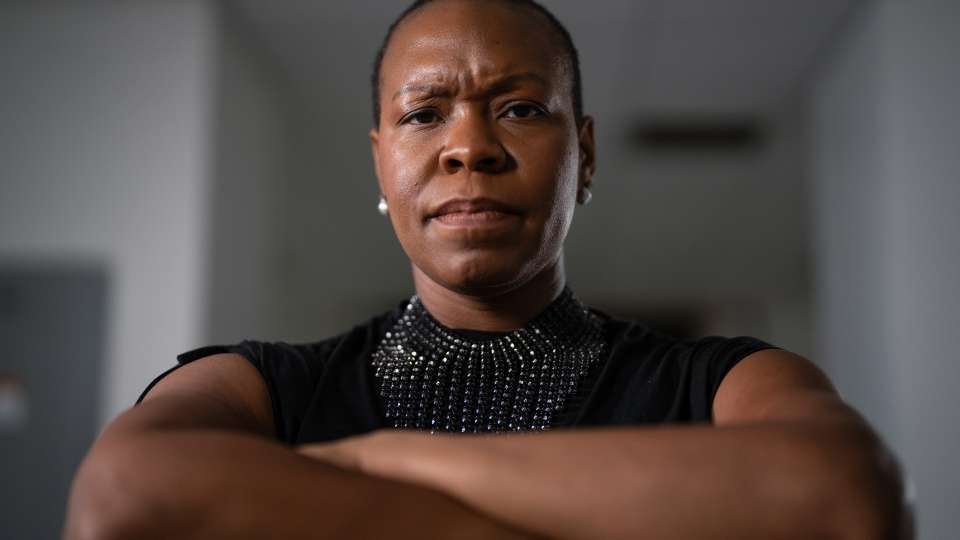
For Watkins, turning her cancer experience into fodder for art has been important for personal meaning-making, she says. And she hopes it inspires others to appreciate their own emotional journeys, no matter what they are going through.
“Some people will say things like, ‘Don’t be sad,’ but it’s OK to be sad,” Watkins says. “Tap into the ways that you can express yourself and have an outlet for the feelings that you’re feeling. Never feel guilty if you’re having joy in the middle of a painful experience, because I know sometimes those feelings come up, too.
“I think it’s about leaning into what you’re feeling and just accepting that for what it is. So you’re in denial? OK, I’m in denial. And I love that about me, because that’s where I am right now. And as you go along, just accept the stages and feelings for what they are.”

